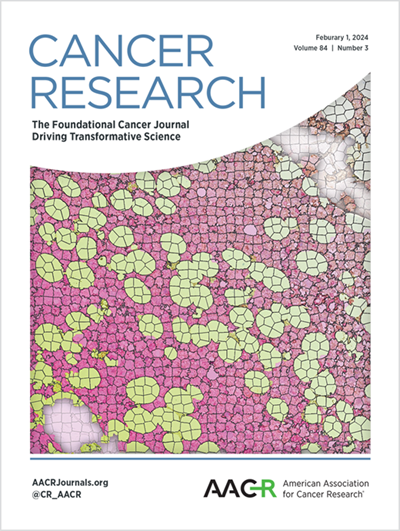荧光寿命成像可对 PD-L1 表达和肿瘤间异质性进行体内定量分析
IF 12.5
1区 医学
Q1 ONCOLOGY
引用次数: 0
摘要
选择患者接受癌症免疫疗法需要精确、定量地读取完整肿瘤中生物标记物的表达情况,并对多个受试者的不同时期进行可靠比较。目前评估免疫疗法反应的临床标准生物标记物是程序性死亡配体-1(PD-L1)的表达,通常使用免疫组化方法进行量化。然而,这种方法只能提供体内外标本微观区域 PD-L1 表达状态的快照。虽然已经研究了多种用于 PD-L1 体内成像的靶向探针,但探针在肿瘤微环境(TME)中的非特异性蓄积阻碍了精确量化,限制了其在临床前和临床研究中的应用。在这里,我们证明了用近红外荧光团 IRDye 800CW (αPDL1-800)标记的抗 PD-L1 抗体的体内时域 (TD) 荧光成像可以定量估计未接受治疗的小鼠体内肿瘤 PD-L1 的基线异质性,以及接受临床相关抗 PD1 治疗的小鼠体内 PD-L1 表达的变化。与 PD-L1 结合的 αPDL1-800 的荧光寿命 (FLT) 明显长于 TME 中非特异性积累的 αPDL1-800 的荧光寿命 (FLT)。这种荧光寿命对比允许使用平面荧光寿命成像对浅表乳腺肿瘤和使用荧光层析成像的渐近 TD 算法对深部肝脏肿瘤(>5 毫米深度)的 PD-L1 表达进行跨小鼠量化。这些研究结果表明,荧光寿命成像可以对不同受试者的受体表达进行可靠的量化,从而加速新免疫疗法的临床前研究和临床转化。本文章由计算机程序翻译,如有差异,请以英文原文为准。
Fluorescence Lifetime Imaging Enables In vivo Quantification of PD-L1 Expression and Inter-tumoral Heterogeneity
Patient selection for cancer immunotherapy requires precise, quantitative readouts of biomarker expression in intact tumors that can be reliably compared across multiple subjects over time. The current clinical standard biomarker for assessing immunotherapy response is programmed death-ligand-1 (PD-L1) expression, typically quantified using immunohistochemistry. This method, however, only provides snapshots of PD-L1 expression status in microscopic regions of ex vivo specimens. While various targeted probes have been investigated for in vivo imaging of PD-L1, non-specific probe accumulation within the tumor microenvironment (TME) has hindered accurate quantification, limiting the utility for preclinical and clinical studies. Here, we demonstrated that in vivo time-domain (TD) fluorescence imaging of an anti-PD-L1 antibody tagged with the near-infrared fluorophore IRDye 800CW (αPDL1-800) can yield quantitative estimates of baseline tumor PD-L1 heterogeneity across untreated mice, as well as variations in PD-L1 expression in mice undergoing clinically relevant anti-PD1 treatment. The fluorescence lifetime (FLT) of PD-L1 bound αPDL1-800 was significantly longer than the FLT of nonspecifically accumulated αPDL1-800 in the TME. This FLT contrast allowed quantification of PD-L1 expression across mice both in superficial breast tumors using planar FLT imaging and in deep-seated liver tumors (>5 mm depth) using the asymptotic TD algorithm for fluorescence tomography. These findings suggest that fluorescence lifetime imaging can accelerate the preclinical investigation and clinical translation of new immunotherapy treatments by enabling robust quantification of receptor expression across subjects.
求助全文
通过发布文献求助,成功后即可免费获取论文全文。
去求助
来源期刊

Cancer research
医学-肿瘤学
CiteScore
16.10
自引率
0.90%
发文量
7677
审稿时长
2.5 months
期刊介绍:
Cancer Research, published by the American Association for Cancer Research (AACR), is a journal that focuses on impactful original studies, reviews, and opinion pieces relevant to the broad cancer research community. Manuscripts that present conceptual or technological advances leading to insights into cancer biology are particularly sought after. The journal also places emphasis on convergence science, which involves bridging multiple distinct areas of cancer research.
With primary subsections including Cancer Biology, Cancer Immunology, Cancer Metabolism and Molecular Mechanisms, Translational Cancer Biology, Cancer Landscapes, and Convergence Science, Cancer Research has a comprehensive scope. It is published twice a month and has one volume per year, with a print ISSN of 0008-5472 and an online ISSN of 1538-7445.
Cancer Research is abstracted and/or indexed in various databases and platforms, including BIOSIS Previews (R) Database, MEDLINE, Current Contents/Life Sciences, Current Contents/Clinical Medicine, Science Citation Index, Scopus, and Web of Science.
 求助内容:
求助内容: 应助结果提醒方式:
应助结果提醒方式:


